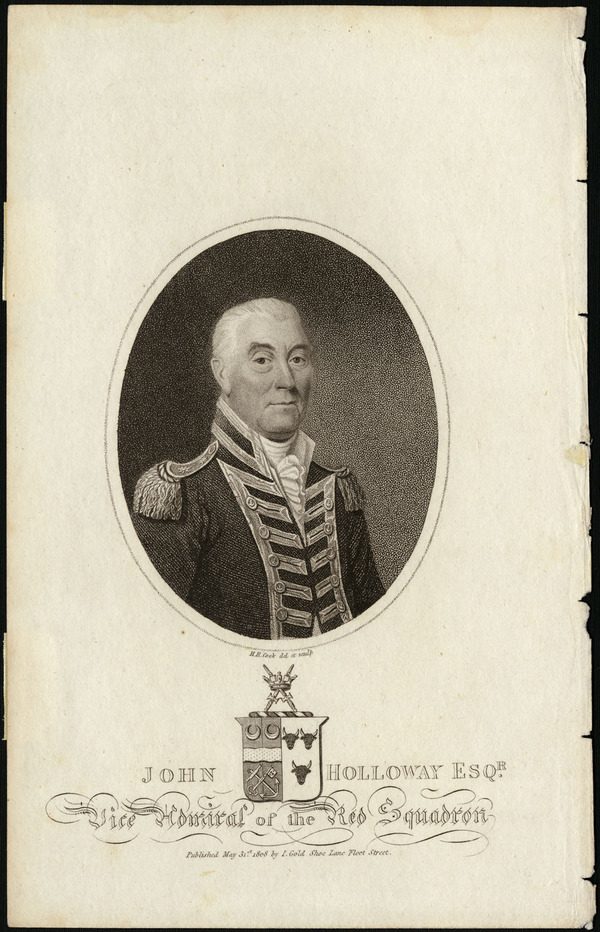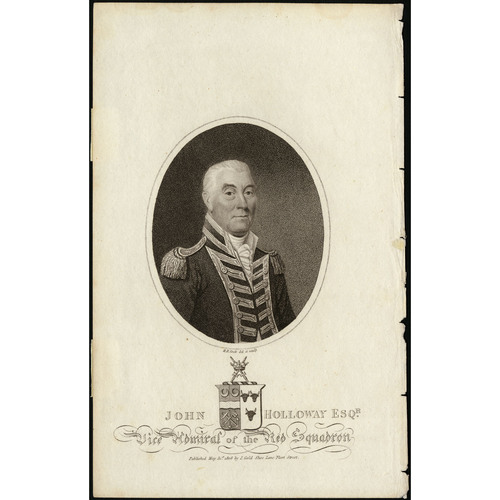HOLLOWAY, JOHN, naval officer and governor of Newfoundland; b. 15 Jan. 1743/44 (Old Style) in the parish of St Cuthbert, Wells, Somerset, England, son of Robert Holloway; m. c. 1781, in the West Indies, Miss Waldron (Walrond) of Antigua, and they had three daughters who reached adulthood; d. 26 June 1826 in Wells.
The son of an old and respectable family, John Holloway entered the Royal Navy in 1760 aboard the Antelope, and the next year made his first trip to Newfoundland with the newly appointed governor, Captain Thomas Graves*. He became a lieutenant on 19 Jan. 1771 and post captain in January 1780. During the American revolution and the long wars with France and Spain, he served with distinction. Horatio Nelson, a friend, called him “an honest, good man.” On 14 Feb. 1799 Holloway was raised to rear-admiral, and on 25 Oct. 1804 to vice-admiral. In 1807 he was appointed governor of Newfoundland.
In his administration Holloway broke with the policy developed by his immediate predecessors, James Gambier and Sir Erasmus Gower*, which recognized the fact of permanent settlement on the island. Instead, he returned to the restrictive views of Hugh Palliser* and Mark Milbanke*. He refused the use of land for cultivation and enforced rigid regulations designed to retain the shore for the transient fishing fleets from England. The times, however, were not with Holloway. An American embargo on the export of foodstuffs and some particularly severe winters made land cultivation important.
Holloway’s views on the freedom of the press were similarly restrictive. The first publication of the St John’s Royal Gazette and Newfoundland Advertiser on 27 Aug. 1807 brought a severe caution to publisher John Ryan*, forbidding the printing of “anything inflammatory against the Government of Great Britain or its dependencies” and warning him “never to give or suffer any opinion to be given upon the policy of other nations but to confine the paper solely for what was to the benefit of commerce, and the inhabitants of this Government and others trading with it.”
Although the Royal Navy was the island’s first line of defence, the inhabitants had a role to play. Holloway was not impressed with the potential value of the militia, officially named the Loyal Volunteers, which had been established in 1805; nevertheless, he encouraged the force’s maintenance. Command of the Loyal Volunteers changed in October 1808, going to James MacBraire. Holloway, modestly pleased, reported that MacBraire was “using every economy, at the same time preserving the utility and respectability of the Corps.”
Holloway was distressed by the inhuman treatment of the Beothuks at the hands of fur traders and fishermen [see John Bland]. He issued a proclamation on 30 July 1807 against it and also tried to stop the influx of Nova Scotia Micmacs, who were moving into the Beothuks’ hunting-grounds. Holloway twice sent one of his officers to the Bay of Exploits and other parts of the island to communicate with the Beothuks, without success. Then he dispatched an expedition under William Cull. It, too, was a failure, and the ugly process of extermination continued.
During Holloway’s tenure, in March 1809, the imperial government finally gave the courts of judicature in Newfoundland their permanence, a step which, if not by intent, at least in fact foreshadowed the granting of colonial status in 1832 [see Sir Thomas John Cochrane*]. The same act of 1809 also reannexed the Labrador coast to Newfoundland’s jurisdiction from that of Lower Canada.
Holloway left the island in October 1809 and the same month was promoted admiral of the blue. On 31 July 1810 he was made admiral of the white. He died in his 80th year. Contemporary observers remarked on his “rigid honesty” and “blunt sincerity,” and found him “brave without ostentation, independent without being assuming . . . a deserving naval commander.”
PRO, CO 194/46: 82; 194/47: 33, 45, 61, 82. Somerset Record Office (Taunton, Eng.), Wells St Cuthbert, reg. of baptisms, 18 Jan., 23 Feb. 1743/44. “Biographical memoir of John Holloway, esq., vice-admiral of the Red, governor of the island of Newfoundland, and commander in chief on that station,” Naval Chronicle (London), 19 (January–June 1808): 353–73. Nelson’s letters to his wife, and other documents, 1785–1831, ed. G. P. B. Naish ([London], 1958), 237. G.B., Admiralty, The commissioned sea officers of the Royal Navy, 1660–1815, [ed. D. B. Smith et al.] (3v., n. p., [ 1954]), 2; Navy list, 1811. John Marshall, Royal naval biography . . . (4v. in 6 and 2v. supp., London, 1823–35), 1: 101–10. R. H. Bonnycastle, Newfoundland in 1842: a sequel to “The Canadas in 1841” (2v., London, 1842), 1: 141–42. Joseph Hatton and Moses Harvey, Newfoundland, the oldest British colony; its history, its present condition, and its prospects in the future (London, 1883). Howley, Beothucks or Red Indians. G. W. L. Nicholson, The fighting Newfoundlander; a history of the Royal Newfoundland Regiment (St John’s, [1964?]). James Ralfe, The naval biography of Great Britain . . . (4v., London, 1828), 2: 209–14.
Cite This Article
Frederic F. Thompson, “HOLLOWAY, JOHN,” in Dictionary of Canadian Biography, vol. 6, University of Toronto/Université Laval, 2003–, accessed September 4, 2024, https://www.biographi.ca/en/bio/holloway_john_6E.html.
The citation above shows the format for footnotes and endnotes according to the Chicago manual of style (16th edition). Information to be used in other citation formats:
| Permalink: | https://www.biographi.ca/en/bio/holloway_john_6E.html |
| Author of Article: | Frederic F. Thompson |
| Title of Article: | HOLLOWAY, JOHN |
| Publication Name: | Dictionary of Canadian Biography, vol. 6 |
| Publisher: | University of Toronto/Université Laval |
| Year of publication: | 1987 |
| Year of revision: | 1987 |
| Access Date: | September 4, 2024 |




